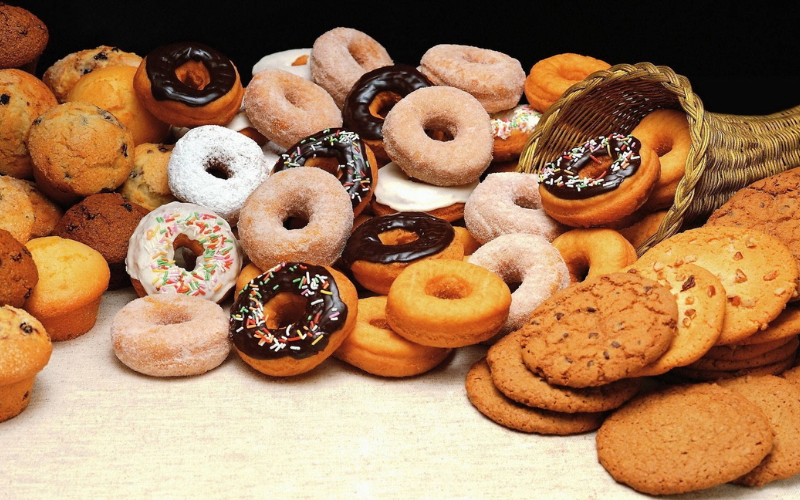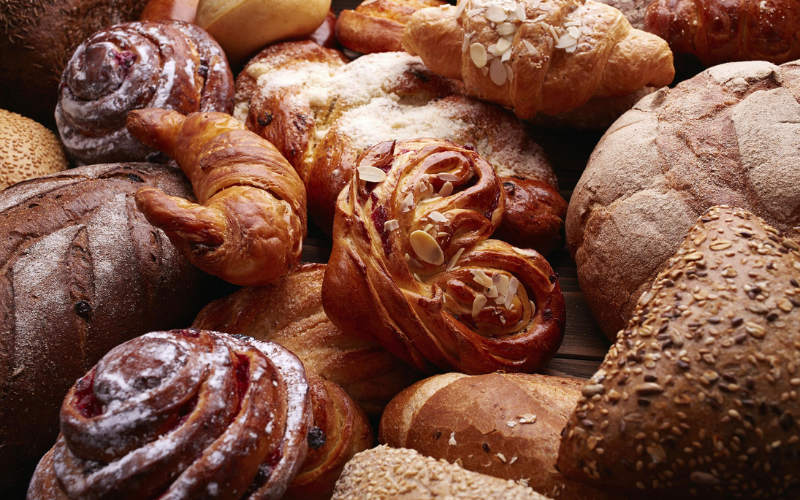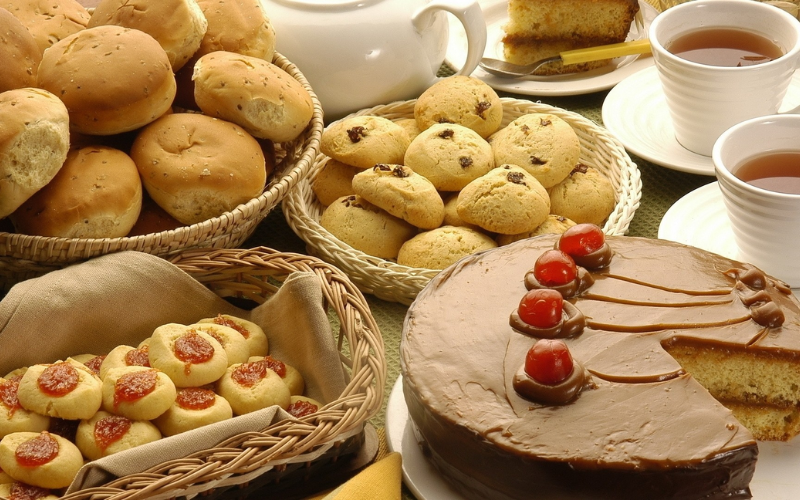Bakery Benefits: Why Freshly Baked Goods Are Better

Walk into a bakery early in the morning. The air is warm, alive with the scent of caramelized sugar and golden crusts. Somewhere, someone just pulled a tray of cinnamon rolls from the oven, and the whole place feels like comfort on a quiet morning. That’s the thing about fresh bakery items: they’re not just food—they’re experiences that stir memory and emotion.
For centuries, baking has been a ritual of community and nourishment. Whether it’s a crusty loaf shared across a table or a warm pastry eaten with coffee on the way to work, baked goods carry a sense of grounding. Freshly baked foods satisfy more than hunger—they tell stories.
Key Takeaways
-
Freshly baked goods offer superior taste, texture, and aroma unmatched by mass-produced alternatives.
-
Locally baked food supports artisanal craftsmanship and sustains the community economy.
-
Real ingredients, minimal preservatives, and shorter shelf lives often mean better nutrition and cleaner flavor.
-
Fresh bakes carry emotional and cultural significance that enhances the eating experience.
-
Visiting a bakery connects you with seasonal and local tastes that reflect genuine craftsmanship.
How Freshness Transforms Taste
It’s not your imagination—fresh bread really does taste better. When baked goods leave the oven, their natural oils, butter, and sugar remain intact, producing a lush flavor and tender mouthfeel. Over time, moisture evaporates, fats solidify, and the chemistry that once blessed a croissant with flakiness begins to fade.
Fresh bakery bread offers that slightly chewy crust and airy crumb that only hours-old baking can deliver. Muffins remain soft, cookies stay supple at the center, and pastries hold their buttery aroma. Once a product sits on a shelf for too long, even if it looks the same, it’s lost part of its sensory magic.
Freshness also allows the subtler flavors—like the nuttiness of whole grains or the tang of natural fermentation—to shine through. Industrial processes often mask these nuances with additives or artificial enhancers to maintain uniform taste. Fresh baking celebrates variety and imperfection in a way no factory line can.
The Nutritional Edge of Fresh Baking
Many people assume baked goods are indulgences—and sometimes they are—but when made fresh, they can also be more wholesome. A local baker, working with real butter, farm eggs, and unbleached flour, produces a cleaner, more balanced result than a packaged alternative.
Store-bought goods rely on stabilizers and preservatives to extend shelf life. While safe, these ingredients do little for nutritional quality. In contrast, fresh baking allows for simpler ingredient lists—no gums, no artificial colors, no mystery “flavor mixes.” That means fewer processed sugars and often better macro balance, particularly in breads that use whole or sprouted grains.
In a world where ingredient transparency matters, freshness doubles as a sign of honesty. You can usually see what goes in—and what stays out.
The Texture Factor: Crispy, Flaky, Soft
Texture often defines why we fall in love with certain baked goods. Think of that crisp edge of a baguette, the soft heart of a brownie, or the layered puff of a Danish. Freshly baked items deliver on all fronts.
Bread straight from the oven has living texture—crispy crust, steam-filled crumb, slightly elastic bite. Cookies baked that morning crumble just enough without becoming dry. This fleeting perfection fades as hours pass and staling begins. That’s why local bakeries work on short cycles, baking in smaller batches to maintain peak texture through the day.
Even the sound—a baguette snapping, a scone breaking apart—tells you the food is alive. Texture is more than sensation; it’s part of the experience that only freshness guarantees.
The Emotional Pull of Fresh Baking
Food memories often hinge on smell. The scent of warm biscuits or freshly baked pies can anchor us to childhood or special moments. Bakeries trade in this kind of nostalgia every day.
There’s an unspoken intimacy in eating something just baked. It feels personal, human, made by hands rather than machinery. That emotional connection builds trust—a reason people return to their neighborhood bakeries even when larger chains sit closer or cheaper.
Freshly baked goods, in many ways, bring people together. A box of muffins shared at work, a loaf of sourdough gifted to a friend, or a pie at a family table: baked food turns ordinary gatherings into meaningful gestures.
Supporting Local Artisans and Communities

Choosing fresh, local baked goods supports more than your taste buds. It strengthens local economies and preserves traditional know-how.
When you visit a bakery in Springfield, IL, you’re not just buying bread—you’re participating in a small ecosystem. Local bakeries often source from nearby farms or mills, reinvesting in regional producers. They might rotate flavors based on the season—apple hand pies in autumn, lemon cakes in spring—tapping into the local agricultural rhythm.
This cycle of sourcing and baking keeps communities resilient. It also helps reduce transportation miles, packaging waste, and food loss associated with mass-distribution baked goods.
In an age where convenience often overshadows quality, choosing local freshness is a quiet yet meaningful act of resistance—one loaf or pastry at a time.
Better for the Planet, One Loaf at a Time
Sustainability plays a growing role in how consumers choose their food. Fresh bakeries tend to produce less waste. Shorter supply chains mean fewer preservatives and a closer match between production and daily demand.
Smaller batches reduce overproduction, while many bakers repurpose leftover bread into bread pudding, croutons, or breadcrumbs. Even unsold items often find new life through donations to local shelters or food recovery initiatives.
Meanwhile, large-scale mass production often leans on heavy packaging, frozen logistics, and preservatives that extend storage but increase carbon impact. Fresh baking eliminates the middle layers, creating a smaller footprint in more ways than one.
Seasonal and Sensory Variety
Fresh bakeries thrive on rhythm—harvest seasons, cultural holidays, regional traditions. In Springfield, for instance, you might find autumn pumpkin loaves, winter stollens dusted in sugar, or summer fruit galettes bursting with color. These fluctuate with the local calendar, creating a sense of belonging to the season.
Unlike standardized brands, local bakers experiment. They test new fillings, mix heritage grains, adjust hydration levels—all in pursuit of nuance. That curiosity is what keeps their shelves dynamic and their customers intrigued.
This ephemeral variety ensures that every visit feels new. There’s joy in discovering what’s different today, in knowing that freshness isn’t just about time but creativity.
Fresh Baking and Healthier Eating Habits
Fresh bakery culture subtly encourages mindful eating. When your bread only lasts a few days, you naturally eat with more awareness, savoring what’s in front of you instead of stockpiling snacks.
Freshly baked items also often have simpler ingredients, helping consumers recognize what their food is made of. You taste the butter, notice the spice, smell the yeast. That sensory awareness reconnects people with their food source—an experience lost when most of our choices come pre-packaged.
Regular patrons often note that fresh bread feels more satisfying; a slice of artisan loaf can genuinely fill you up faster than store-bought white versions filled with additives. Over time, that means smaller portions and better control over sugar and carb intake.
Why Consumers Keep Returning to Fresh
Beyond taste and nutrition, there’s trust. People can watch bakers work, smell the results, and see transparent processes. That daily connection fosters loyalty.
Freshness becomes an experience customers want to repeat. Some visit bakeries as part of a morning ritual; others see it as a comforting escape during the day. Either way, the cycle of freshness invites participation—you’re not just a buyer but a witness to something handmade in real time.
In Springfield’s lively local scene, bakeries set themselves apart not by marketing budgets but by authenticity. Shoppers increasingly crave that tangible connection—knowing their bread didn’t travel hundreds of miles or sit frozen for months.
A Community Hub, Not Just a Counter
Walk into a small-town bakery, and you’ll notice conversations as warm as the ovens. These places often become informal gathering points—neighbors chatting over coffee, parents picking up treats for weekends, bakers sharing samples from a new batch.
This connection adds social nutrition to physical nourishment. Food tastes richer when shared, and bakeries embody that daily rhythm of community exchange. Supporting these spaces sustains more than a business model—it keeps traditions alive.
The Science Behind Stale
What really happens when baked goods go stale? Flour-based foods contain starch molecules that re-crystallize over time, a process called retrogradation. As moisture migrates, texture declines, leading to that familiar dry, tough sensation. Refrigeration can even accelerate staling by disrupting starch structure.
Fresh bakery items sidestep this because they’re meant for near-term enjoyment. Bakers design their recipes around immediate texture, optimal moisture, and flavor balance—no artificial extensions required.
That’s why timing matters so much. The difference between bread baked at dawn and sold by afternoon versus one baked three days ago is a world apart chemically and sensorially.
Rediscovering Rituals of Real Food
In a fast-paced world, processes like kneading dough or waiting for fermentation symbolize patience. Buying fresh bread or pastries brings some of that patience back into our lives. It reminds us that food still involves human rhythm—time, touch, and care.
The ritual of visiting a bakery can become an act of slowing down, reconnecting with local life. It’s a way to celebrate everyday abundance rather than speed.
For families, fresh baking can spark small traditions: Sunday morning cinnamon rolls, artisan bread with homemade soup, or birthday cakes tailored locally with genuine ingredients. These rituals nourish continuity in home life.
Taste, Texture, Tradition—The Perfect Trio

Every culture holds its own baked treasures—baguettes, challah, empanadas, naan, pandesal—and yet, they all share one truth: freshness defines their glory. Reheated, processed, or pre-packaged versions lose that touch of life.
It’s not about perfection but vitality. The irregularities—slightly uneven crusts, air pockets, tanned edges—mark authenticity. Modern food trends increasingly celebrate this handmade imperfection as a badge of integrity.
That’s the power of freshly baked goods: they stand for something human.
Conclusion
Freshly baked food doesn’t just feed us—it reminds us what eating is meant to feel like. Every loaf, cookie, and cake carries the warmth of craftsmanship, the trace of local flavor, and the rhythm of daily renewal. Choosing fresh supports your health, your community, and your environment, all while filling your home with something that can’t be replicated on a shelf.
If you’re looking for that unmatched aroma, taste, and connection, there’s always a story waiting to be told inside a neighborhood bakery—one baked good at a time.
Frequently Asked Questions
1. Why do freshly baked goods taste better than packaged ones?
Because they retain natural moisture, aroma, and fat integrity, which create fuller flavors and better texture.
2. How long do fresh bakery items typically last?
Most breads stay best for two to three days, pastries for one to two. Storing them in breathable bags helps prolong freshness slightly.
3. Are freshly baked goods healthier?
They often use fewer preservatives and more natural ingredients, which can make them cleaner nutritionally, though moderation still matters.
4. Can fresh bakery items be frozen for later use?
Yes. Many breads and pastries freeze well when wrapped tightly. Thawing at room temperature preserves most of their texture.
5. Why support local bakeries instead of buying from big stores?
Local bakeries support community economies, use seasonal ingredients, and deliver fresher, higher-quality products with minimal additives.


